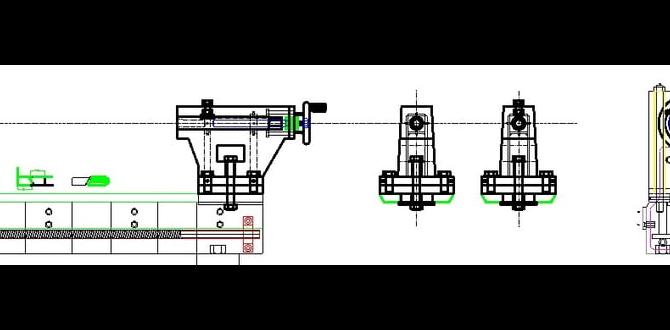Tialn Ball Nose End Mills are a fantastic choice for machining stainless steel, offering durable cutting and excellent finishes, especially for challenging materials like 316 stainless steel and thin-wall applications due to their TiAlN coating and specific geometry.
Tackling stainless steel with your milling machine can feel like a wrestling match. It’s tough, galls easily, and traditional cutters often wear out fast, leaving you with frustrating results. You might have heard about special coatings and geometries, but what actually works? If you’re looking for a reliable way to cut stainless steel, especially those trickier grades like 316 or delicate thin walls, then understanding the TiAlN ball nose end mill is your next best step. We’re going to break down why this specific tool is a game-changer and how you can use it effectively to achieve smooth cuts and long tool life. Get ready to boost your confidence and your machining projects!
Why Stainless Steel is a Milling Challenge
Stainless steel, loved for its strength and corrosion resistance, presents unique challenges when it comes to machining. Its high tensile strength means it requires more force to cut. It also has a tendency to work-harden, meaning the material gets harder the more you cut it – a real problem for cutting tools. Furthermore, stainless steel has poor thermal conductivity, so heat generated during cutting tends to stay in the tool, leading to premature wear. All these factors combine to make it notoriously difficult to machine cleanly and efficiently without the right tooling.
Understanding the TiAlN Coating
The secret to many high-performance cutting tools lies in their coatings. TiAlN stands for Titanium Aluminum Nitride. This is a super-hard ceramic compound applied to the cutting tool’s surface, typically through a Physical Vapor Deposition (PVD) process.
Here’s why TiAlN is so good for stainless steel:
Extreme Hardness: It significantly increases the surface hardness of the end mill, making it resistant to abrasion from the tough stainless steel.
High Heat Resistance: TiAlN can withstand very high temperatures without losing its hardness. This is crucial because stainless steel generates a lot of heat during machining. The coating acts as a thermal barrier, protecting the tool’s core.
Reduced Friction: The coating helps to reduce the friction between the cutting tool and the workpiece. This means less heat buildup and less tendency for the stainless steel to “galls” or weld itself to the cutting edge.
Oxidation Resistance: At higher machining temperatures, TiAlN forms a protective aluminum oxide layer, further enhancing its heat and wear resistance.
This combination of properties makes TiAlN-coated tools ideal for working with materials that are otherwise difficult to machine, like various grades of stainless steel.
The Ball Nose End Mill: More Than Just a Shape
A ball nose end mill has a hemispherical tip, meaning the cutting edges at the very end are curved and meet at a rounded point. This shape is incredibly versatile and offers distinct advantages, especially when paired with a robust coating like TiAlN for stainless steel.
Key features and benefits of a ball nose end mill for stainless steel include:
3D Machining and Contouring: The rounded tip is perfect for creating complex 3D shapes, contours, and fillets. It can plunge directly into material (with appropriate feed rates) and generate smooth, sweeping surfaces.
Slotting and Pocketing: While not its primary design, a ball nose can be used for shallow slots or pockets, especially if the radius of the end mill matches the desired corner radius of the pocket.
Reduced Stress Concentration: Unlike square-shouldered end mills, the rounded tip distributes cutting forces more evenly, reducing stress on the tool and the workpiece. This is a significant advantage when machining thin-walled parts or delicate features.
Improved Surface Finish: The continuous, curved cutting action of a ball nose end mill can often lead to better surface finishes compared to flat-bottomed tools, particularly in materials prone to chipping or gummy behavior.
When you combine the advanced TiAlN coating with the geometric advantages of a ball nose end mill, you get a tool specifically engineered to overcome the challenges of machining stainless steel effectively.
Top Considerations for TiAlN Ball Nose End Mills in Stainless Steel
Choosing the right TiAlN ball nose end mill involves looking beyond just the coating. Several factors contribute to its success, especially when dealing with specific stainless steel grades or complex geometries.
Materials They Excel With
While TiAlN ball nose end mills are excellent for stainless steels, they also perform well on other challenging materials that benefit from high-temperature resistance and hardness.
Stainless Steels: Austenitic (like 304, 316), Martensitic, and Duplex stainless steels. Grade 316, in particular, is known for its increased toughness, making a TiAlN coated tool a significant advantage.
High-Temperature Alloys: Inconel, Hastelloy, and other nickel-based superalloys.
Titanium: Pure titanium and its alloys.
Tool Steels: Some hardened tool steels.
Key Specifications to Look For
When selecting a TiAlN ball nose end mill, pay close attention to these specifications:
Diameter: The overall cutting diameter of the mill.
Radius: The radius of the ball tip (determines the corner radius it can cut or the depth of cut in a single pass for contoured shapes).
Number of Flutes: Typically 2, 3, or 4 flutes. For stainless steel, fewer flutes (like 2 or 3) are often preferred for better chip evacuation and less friction, while 4 flutes can be used with optimized speeds and feeds for finishing.
Shank Diameter: The diameter of the part that fits into the tool holder.
Overall Length (OAL) & Length of Cut (LOC): Important for reach and depth requirements.
Coating: Ensure it is indeed TiAlN. Some mills may have variations or multiple coatings, but TiAlN is the standard workhorse for this application.
Material of the End Mill Itself: High-speed steel (HSS) or, more commonly for this application, solid carbide. Carbide offers greater rigidity and wear resistance, which is crucial for stainless steel.
The 55-Degree Ball Nose End Mill Explained for Stainless Steel
You might see specifications like “55-degree ball nose end mill.” This refers to the angle of the cutting flutes relative to the axis of the tool. A 55-degree helical flute angle, often referred to as an “arc” or “contour” end mill, is designed for aggressive material removal and excellent surface finish in stainless steel and other difficult alloys.
Benefits of a 55-Degree Angle:
Reduced Cutting Forces: The higher helix angle helps to reduce the axial forces during cutting, making it easier to machine materials like stainless steel without chatter or excessive tool deflection.
Improved Chip Evacuation: The steeper helix provides a cleaner path for chips to exit the cutting zone, which is vital for preventing recutting and workpiece damage in gummy materials.
Better Surface Finish: This design often contributes to a smoother surface finish, especially in materials that tend to gall.
Plunge and Ramp Capabilities: Many tools with higher helix angles are optimized for plunging and ramping into the material, which is common in 3D contouring.
This specific design is a significant advantage for any machinist dealing with the intricacies of stainless steel, especially when precise contours or thin sections are involved.
Practical Application: Machining Stainless Steel with TiAlN Ball Nose End Mills
Using your TiAlN ball nose end mill effectively for stainless steel involves more than just putting it in the machine. Proper setup, speeds, feeds, and machining strategies are key to achieving great results and maximizing tool life.
Choosing the Right Speeds and Feeds
This is often the most critical factor. Stainless steel requires different parameters than softer metals like aluminum or mild steel.
Cutting Speed (Surface Feet per Minute – SFM or Surface Meters per Minute – SMM): For TiAlN coated carbide, start with conservative values and adjust. A good starting point for 316 stainless steel with a TiAlN ball nose end mill might be in the range of 250-450 SFM (75-135 SMM). Always consult the tool manufacturer’s recommendations.
Feed Rate (Inches per Tooth – Ipt or Millimeters per Tooth – Mmr/T): This is directly related to the cutting speed and the number of flutes. Adequate chip load is crucial to prevent the tool from rubbing and generating excessive heat. For a 1/4″ diameter end mill, start with a feed per tooth of 0.001″ – 0.002″ (0.025mm – 0.05mm). For larger diameters, this can increase.
Depth of Cut (DOC) and Width of Cut (WOC): Stainless steel benefits from a sufficient depth of cut, especially with ball nose end mills. This helps the tool engage the material efficiently and create a proper chip. For roughing, a step-over (WOC) of 30-50% of the tool diameter and a depth of cut (DOC) of 50-100% of the radius (for the ball nose) can be effective. For finishing, much smaller step-overs (10-20%) and depths are used.
Important Note: These are just starting points. Always refer to the specific recommendations from your end mill manufacturer. Factors like machine rigidity, coolant usage, and the specific grade of stainless steel will influence optimal settings.
The Importance of Coolant/Lubrication
Machining stainless steel generates significant heat. Effective cooling and lubrication are non-negotiable.
Flood Coolant: A generous supply of high-quality cutting fluid is ideal. It cools the cutting edge, flushes away chips, and lubricates the cutting zone, reducing friction and galling.
Minimum Quantity Lubrication (MQL): If flood coolant isn’t an option, MQL systems dispense a fine mist of lubricant, offering good cooling and lubrication with less mess.
Cutting Paste/Stick: For very small operations or machines without built-in coolant, a good quality cutting paste or stick can provide essential lubrication at the cutting edge.
Never dry machine stainless steel with a TiAlN ball nose end mill. The heat generated will quickly destroy the coating and the tool.
Machining Thin-Walled Stainless Steel
Thin-walled parts are notoriously difficult to machine due to their tendency to deflect, vibrate, and become deformed by cutting forces. TiAlN ball nose end mills offer several advantages here.
Reduced Cutting Forces: The geometry and coating help minimize the chewing forces that can distort thin walls.
Workpiece Integrity: Using a lower step-over (WOC) and often a slightly lower feed rate per tooth can reduce the lateral forces on the thin wall, preserving its shape.
Ramping and Helical Interpolation: For pocketing or creating contours in thin walls, techniques like ramping or helical interpolation (where compatible with the tool and machine) can reduce cutting forces by gradually engaging the material.
Fixturing: The best “tool” for thin-walled parts is often excellent fixturing. Ensure the part is well-supported and clamped without distorting it. This might involve vacuum fixturing, custom soft jaws, or internal support structures.
When machining thin walls, aim for a lighter chip load and a smaller depth of cut. Focus on achieving a good surface finish with minimal force. The TiAlN coating helps the tool glide through the material more smoothly, reducing the chances of chatter and deformation. For example, when contouring a thin stainless steel bracket, a 55-degree ball nose end mill with a small radius and a very small step-over will be key.
Machining Grade 316 Stainless Steel
Grade 316 is a popular austenitic stainless steel known for its excellent corrosion resistance, especially in saline environments. However, this comes with increased toughness and a higher tendency to gall compared to some other grades like 304.
Tooling Choice: A TiAlN coated carbide ball nose end mill is highly recommended for 316. The coating’s hardness and heat resistance are vital.
Speeds and Feeds: You’ll likely need to run slightly slower cutting speeds and ensure a robust feed rate per tooth to achieve a good chip. Too slow a feed and the cutter will rub, work-harden the material, and overheat.
Coolant is Crucial: Do not skimp on coolant or lubricant when cutting 316. The material generates significant heat, and effective cooling is paramount to prevent tool failure and poor surface finish.
Generous Chip Load: Aim to get a decent chip load to ensure you’re cutting, not rubbing. This means a sufficient feed per tooth, combined with appropriate depth and width of cut.
A specific example would be using a 1/2″ diameter, 55-degree TiAlN ball nose end mill to create a smoothly radiused internal corner in a 316 stainless steel workpiece. You might start around 300 SFM and a feed per tooth of 0.0015″ with a depth of cut of 0.050″ and a step-over of 0.020″ for finishing.
Tool Holder and Machine Considerations
The best end mill in the world won’t perform well if not properly supported by the machine and its holding system.
Rigidity is King
Machine Spindle: A rigid spindle with minimal runout is essential. Excessive runout will cause uneven cutting, poor surface finish, and premature tool wear.
Tool Holder: Use a high-quality tool holder. For milling stainless steel, collet chucks or shrink-fit holders are far superior to standard drill chucks or basic collet holders. They offer excellent concentricity and rigidity, gripping the end mill shank firmly for improved performance.
Tool Length: Keep the tool stick-out (the length of the end mill extending beyond the tool holder) as short as possible. Longer stick-out increases the risk of vibration, deflection, and runout, all of which are detrimental when machining tough materials.
Coolant Delivery
Ensure your coolant system is delivering fluid directly to the point of cut effectively. Through-spindle coolant can be a significant advantage when available, as it directs coolant right to the flutes. However, even external coolant nozzles, if positioned correctly, can make a huge difference.
Example Setup for Thin-Wall Stainless Steel
Imagine you’re milling a thin-walled housing from 316 stainless steel.
1. Machine: A rigid milling machine ( Bridgeport-style, VMC, etc.) with a well-maintained spindle.
2. Tool Holder: A high-precision collet chuck (e.g., ER40, ER32) with a high-quality, sharp collet.
3. End Mill: A 1/4″ diameter, 55-degree TiAlN coated carbide ball nose end mill with 2 flutes. Keep the stick-out to a minimum – just enough to clear the part or fixture.
4. Coolant: Flood coolant at a good flow rate.
5. Speeds/Feeds (Starting Point):
SFM: 300 (approximate, depends on exact grade)
Ipt: 0.001 – 0.0015
DOC: 0.025″
WOC (for contouring): 0.010″ – 0.020″ (very light to minimize deflection)
This setup emphasizes rigidity, chip control, and minimizing forces for a difficult application.
Troubleshooting Common Issues
Even with the right tools, you might encounter problems. Here’s how to address them.
Chatter or Vibration
Cause: Machine rigidity, worn tool holder, wrong speeds/feeds, excessive tool stick-out, too deep a cut, dull tool.
Solution:
Reduce depth of cut and/or width of cut.
Increase feed rate per tooth slightly to create a “cutting” chip rather than a “rubbing” one.
Ensure you’re using the shortest possible tool stick-out.
Check and improve runout on your tool holder.
Use fewer flutes (e.g., 2 instead of 4).
Consider a more rigid machine or workholding setup.
Poor Surface Finish
Cause: Dull tool, insufficient coolant, wrong speeds/feeds, tool deflection, excessive tool stick-out, material galling.
Solution:
Ensure the end mill is sharp – a TiAlN coating should provide good edge retention, but coatings can wear.
Increase coolant flow.
Adjust feed per tooth. Sometimes a slightly higher feed rate can improve finish by creating a more defined chip.
Reduce depth of cut and width of cut.
Use a tighter tool holder and minimize stick-out.
If galling is suspected, try slightly higher speeds and feeds, or a different lubricant.
Rapid Tool Wear
Cause: Incorrect speeds/feeds (too high or too low), lack of coolant, material hardness, cutting dry.
Solution:
Verify your speeds and feeds against manufacturer recommendations.
Ensure consistent and adequate coolant delivery.
Confirm you are machining the intended material grade.
Machine with appropriate chip loads to avoid rubbing.
Workpiece Deformation (Thin Walls)
Cause: Excessive cutting forces, improper fixturing, too aggressive a cut.
Solution:
Significantly reduce depth of cut and width of cut.
Use optimal fixturing to support the thin wall.
Ensure the machine and tool setup are rigid to minimize vibration that can exacerbate deformation.
* Focus on finishing passes with very light engagement.
This table summarizes common issues and their solutions:






